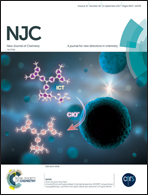Optical and XPS evidence for the electrochemical generation of an N-heterocyclic carbene and its CS2 adduct from the ionic liquid [bmim][PF6]†
Abstract
Room temperature ionic liquids continue to be at the forefront of chemistry, covering a broad spectrum of research areas from electrochemistry and energy to catalysis and green chemistry. Therefore, it is of great value to fully understand the chemical and electrochemical reactivity and stability of ionic liquids utilized in these applications. In this context, we have investigated the electrochemical generation of an N-heterocyclic carbene and its CS2 adduct from the ionic liquid [bmim][PF6], and X-ray photoelectron spectroscopy (XPS) proved to be a highly effective spectroscopic tool to study such systems. Initially, the dithiocarboxylate adduct was chemically synthesized as a reference compound starting from both [bmim][PF6] and [bmim][OAc], and characterized by HRMS, and 1H- and 13C-NMR, FTIR, visible and X-ray photoelectron spectroscopy. While a simple mixture of [bmim][PF6] and CS2 revealed no evidence of adduct formation, the application of an electrochemical stimulus led to the formation of the dithiocarboxylate adduct as evidenced optically and through the newly formed S2p peak in the XP spectrum. Further evidence for the electrochemical reduction of [bmim][PF6] to the corresponding N-heterocyclic carbene came from the XPS analysis via the appearance of a new N1s peak in the XP spectrum.
![Graphical abstract: Optical and XPS evidence for the electrochemical generation of an N-heterocyclic carbene and its CS2 adduct from the ionic liquid [bmim][PF6]](/en/Image/Get?imageInfo.ImageType=GA&imageInfo.ImageIdentifier.ManuscriptID=C7NJ01996C&imageInfo.ImageIdentifier.Year=2017)


 Please wait while we load your content...
Please wait while we load your content...